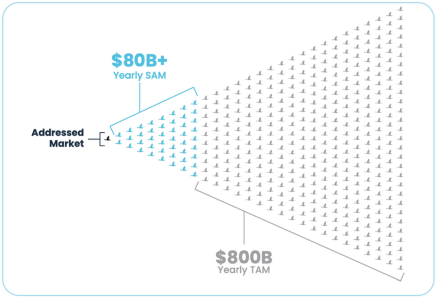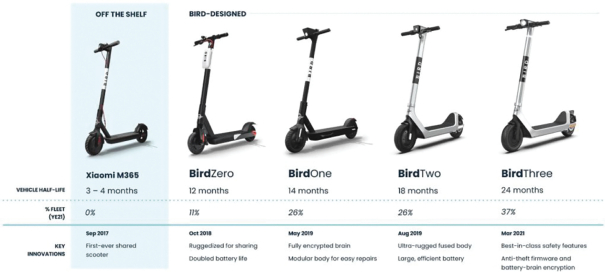As filed with the U.S. Securities and Exchange Commission on March 15, 2022.
Registration No. 333-261137
UNITED STATES
SECURITIES AND EXCHANGE COMMISSION
Washington, D.C. 20549
Post-Effective Amendment No. 1
to
FORM
REGISTRATION STATEMENT
UNDER
THE SECURITIES ACT OF 1933
(Exact name of registrant as specified in its charter)
Delaware |
7389 |
86-3723155 | ||
(State or other jurisdiction of |
(Primary Standard Industrial |
(I.R.S. Employer | ||
incorporation or organization) |
Classification Code Number) |
Identification Number) |
392 NE 191st Street
#20388
Miami, Florida 33179
(866)
205-2442
(Address, including zip code, and telephone number, including area code, of registrant’s principal executive offices)
Lisa Murison
General Counsel
Bird Global, Inc.
392 NE 191st Street #20388
Miami, Florida 33179
(866)
205-2442
(Name, address, including zip code, and telephone number, including area code, of agent for service)
Copies to:
Rachel W. Sheridan, Esq.
Christopher J. Clark, Esq.
Latham & Watkins LLP
555 Eleventh St. NW
Washington, District of Columbia 20004
(202)
637-2200
Approximate date of commencement of proposed sale to the public:
If any of the securities being registered on this Form are to be offered on a delayed or continuous basis pursuant to Rule 415 under the Securities Act of 1933 check the following box: ☒
If this Form is filed to register additional securities for an offering pursuant to Rule 462(b) under the Securities Act, please check the following box and list the Securities Act registration statement number of the earlier effective registration statement for the same offering: ☐
If this Form is a post-effective amendment filed pursuant to Rule 462(c) under the Securities Act, check the following box and list the Securities Act registration statement number of the earlier effective registration statement for the same offering: ☐
If this Form is a post-effective amendment filed pursuant to Rule 462(d) under the Securities Act, check the following box and list the Securities Act registration statement number of the earlier effective registration statement for the same offering: ☐
Indicate by check mark whether the registrant is a large accelerated filer, an accelerated filer, a
non-accelerated
filer, a smaller reporting company, or an emerging growth company. See the definitions of “large accelerated filer,” “accelerated filer,” “smaller reporting company,” and “emerging growth company” in Rule 12b-2
of the Exchange Act: | Large accelerated filer | ☐ | Accelerated filer | ☐ | |||
Non-accelerated filer |
☒ | Smaller reporting company | ||||
| Emerging growth company | ||||||
If an emerging growth company, indicate by check mark if the registrant has elected not to use the extended transition period for complying with any new or revised financial accounting standards provided pursuant to Section 7(a)(2)(B) of the Securities Act: ☒
The registrant hereby amends this registration statement on such date or dates as may be necessary to delay its effective date until the registrant shall file a further amendment which specifically states that this registration statement shall thereafter become effective in accordance with Section 8(a) of the Securities Act or until this registration statement shall become effective on such date as the U.S. Securities and Exchange Commission, acting pursuant to said Section 8(a), may determine.
EXPLANATORY NOTE
This Post-Effective Amendment No. 1 (this “Post-Effective Amendment No. 1”) to the Registration Statement on Form
S-1
(File No. 333-261137)
(the “Registration Statement”), as originally declared effective by the U.S. Securities and Exchange Commission (the “SEC”) on November 26, 2021, is being filed to include information contained in the registrant’s Annual Report on Form 10-K
for the fiscal year ended December 31, 2021, which was filed with the SEC on March 15, 2022, and to update certain other information in the Registration Statement. The information included in this filing amends the Registration Statement and the prospectus contained therein. No additional securities are being registered under this Post-Effective Amendment No. 1. All applicable registration fees were paid at the time of the original filing of the Registration Statement on November 17, 2021.
SUBJECT TO COMPLETION, DATED MARCH 15, 2022
The information in this preliminary prospectus is not complete and may be changed. These securities may not be sold until the registration statement filed with the U.S. Securities and Exchange Commission is effective. The preliminary prospectus is not an offer to sell these securities and does not constitute the solicitation of offers to buy these securities in any jurisdiction where the offer or sale is not permitted.

BIRD GLOBAL, INC.
147,709,784 SHARES OF CLASS A COMMON STOCK
6,596,000 WARRANTS TO PURCHASE SHARES OF CLASS A COMMON STOCK
12,874,972 SHARES OF CLASS A COMMON STOCK UNDERLYING WARRANTS
This prospectus relates to the resale from time to time of (i) an aggregate of 145,484,784 shares of Class A common stock, par value $0.0001 per share (the “Class A common stock”), of Bird Global, Inc., a Delaware corporation (“Bird Global”), issued or issuable in connection with the Business Combination (as defined below), by the selling securityholders named in this prospectus (each a “selling securityholder” and, collectively, the “selling securityholders”), (ii) 6,596,000 warrants to purchase Class A common stock at an exercise price of $11.50 per share (the “Sponsor Warrants,” which includes 6,550,000 warrants that are “private placement warrants” under the Warrant Agreement (as defined below) (the “private placement warrants”) by certain of the selling securityholders, and (iii) the issuance by us and resale of up to 2,225,000 shares of Class A common stock reserved for issuance upon the settlement of stock-based awards. This prospectus also relates to the issuance by us of up to 12,874,972 shares of Class A common stock upon the exercise of outstanding private placement warrants and public warrants (the “public warrants” and, together with the private placement warrants, the “warrants”).
On November 4, 2021 (the “Acquisition Closing Date”), we consummated the transactions contemplated by that certain Business Combination Agreement, dated as of May 11, 2021, by and among Switchback II Corporation, a Cayman Islands exempted company (“Switchback”), Maverick Merger Sub Inc., a Delaware corporation and a direct wholly owned subsidiary of Switchback (“Merger Sub”), Bird Rides, Inc., a Delaware corporation (“Bird Rides”), and Bird Global (as amended from time to time, the “Business Combination Agreement”), which provided for: (1) the merger on November 3, 2021 of Switchback with and into Bird Global, with Bird Global surviving as a publicly traded entity and the sole owner of Merger Sub (the “Domestication Merger”); (2) the merger on the Acquisition Closing Date of Merger Sub with and into Bird Rides, with Bird Rides continuing as the surviving entity and a wholly owned subsidiary of Bird Global (the “Acquisition Merger”); and (3) the other transactions contemplated therein (collectively, the “Business Combination”).
We are registering the resale of shares of Class A common stock and Sponsor Warrants as required by (i) that certain Amended and Restated Registration Rights Agreement, dated as of the Acquisition Closing Date (as amended from time to time, the “Registration Rights Agreement”), by and among us, NGP Switchback II, LLC, a Delaware limited liability company (the “Sponsor”), certain affiliates of Switchback prior to the Acquisition Merger (together with the Sponsor, the “Sponsor Holders”), and certain holders of Bird Rides securities prior to the Acquisition Merger (the “Bird Rides Holders”), and (ii) those certain subscription agreements, each dated May 11, 2021 (as amended from time to time, the “Subscription Agreements”), entered into by and between Switchback and certain qualified institutional buyers and accredited investors (the “PIPE Investors”) that purchased shares of Class A common stock in private placements consummated in connection with the Business Combination (the “PIPE Financing”). We are registering the issuance of shares of Class A common stock upon exercise of warrants as required by that certain Warrant Agreement, dated as of January 7, 2021, between Switchback and Continental Stock Transfer & Trust Company, as warrant agent (the “Warrant Agreement”).
We are also registering the issuance and resale of shares of Class A common stock reserved for issuance upon the settlement of
stock-based
awards held by certain of our current and former service providers. We will receive the proceeds from any exercise of the warrants or stock options for cash, but not from the resale of any shares of Class A common stock or Sponsor Warrants by the selling securityholders covered by this prospectus.
We will bear all costs, expenses, and fees in connection with the registration of the shares of Class A common stock and Sponsor Warrants. The selling stockholders will bear all commissions and discounts, if any, attributable to their respective sales of the shares of Class A common stock and Sponsor Warrants.
Our shares of Class A common stock are listed on The New York Stock Exchange (the “NYSE”) under the symbol “BRDS.” On March 14, 2022, the closing sale price of our Class A common stock was $3.68 per share. Our public warrants are listed on the NYSE under the symbol “BRDS WS.” On March 14, 2022, the closing sale price of our public warrants was $0.54 per warrant.
We are an “emerging growth company” and a “smaller reporting company” under the federal securities laws and will be subject to reduced disclosure and public reporting requirements. See “Summary—Implications of Being an Emerging Growth Company and a Smaller Reporting Company.”
Investing in shares of our Class A common stock or warrants involves risks that are described in the “Risk Factors” section beginning on page 14 of this prospectus.
Neither the U.S. Securities and Exchange Commission (the “SEC”) nor any state securities commission has approved or disapproved of the securities to be issued under this prospectus or determined if this prospectus is truthful or complete. Any representation to the contrary is a criminal offense.
The date of this prospectus is , 2022.
TABLE OF CONTENTS
Page |
||||
1 |
||||
14 |
||||
53 |
||||
54 |
||||
55 |
||||
78 |
||||
94 |
||||
101 |
||||
112 |
||||
116 |
||||
123 |
||||
127 |
||||
139 |
||||
141 |
||||
144 |
||||
144 |
||||
145 |
||||
F-1 |
||||
You should rely only on the information contained in this prospectus or any amendment or supplement to this prospectus. This prospectus is an offer to sell only the securities offered hereby, but only under the circumstances and in jurisdictions where it is lawful to do so. Neither we nor the selling securityholders have authorized anyone to provide you with information different from that contained in this prospectus or any amendment or supplement to this prospectus. Neither we nor the selling securityholders take any responsibility for, or can provide any assurance as to the reliability of, any information other than the information in this prospectus or any amendment or supplement to this prospectus. The information in this prospectus or any amendment or supplement to this prospectus is accurate only as of its date, regardless of the time of delivery of this prospectus or any amendment or supplement to this prospectus, as applicable, or any sale of the securities offered by this prospectus. Our business, financial condition, results of operations, and prospects may have changed since that date.
For Investors Outside the United States
i







